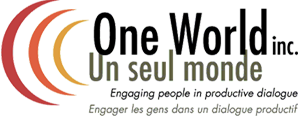Even after the brainstorming is completed, goals are set, the roadmap defined and processes are set into action, there is one more key element to consider in order to ensure the deployment of a successful community development initiative.
That important component is communication. After all, if nobody, including those involved in the initiative, can understand or communicate the project goals and metrics, then it becomes difficult for an initiative to build momentum. It is essential to develop the right tools to help organizations communicate project goals, preconditions for success, and ongoing evaluative results.
When dealing with complex issues such as homelessness, poverty, or street-involved youth, it is a real challenge to communicate effectively in a way that makes the issue and initiative understood, yet doesn’t oversimplify it.
Why is communication a priority with community development projects?
- When trying to engage other partners in work with an organization, they need to have clear idea of the initiative: what the issue is, what the broader societal impact of that issue is, why and how an organization is involved in tackling the issue, and how each partner is being asked to participate in the initiative.
- When trying to engage funders or the government, the specifics of the pitch being made needs to be clear. Organizations needs to clearly communicate how they view the issue, how they’re involved in tackling the issue, and where and why the other prospects would fit as funding partners. Funding partners are always, of course, interested in results; so implementing organizations need to devise an evaluative framework and system for communicating project results.
- When trying to engage the broader public, it is important to communicate the value of an initiative in helping to address a social issue. The media and public are amazing partners who can help build momentum, contribute with grassroots initiatives, and add creative thought leadership to development projects.
Although there can be many levels and types of “engagement”, the success of a community-based initiative depends most upon the active participation on the organizing committees/ working groups. Many initiatives are led by a smaller core group of people, with others joining in for short periods of time. Communication, therefore, needs to flourish within the core group of participants.
Theory of Change: A Communication and Evaluative Tool
When it comes to developing a tool that aids organizations in communicating their goals, preconditions, and results in a way that gives due recognition to complexity, yet breaks down the issue into understandable pieces, the Theory of Change model stands above the rest.
The Theory of Change gives practitioners an opportunity to understand and map all of the aspects of complex social issues in detail, incorporating all contributing factors – some of which are obvious, some of which are not. This provides a framework around which participants and partners can gather and discuss an issue. The model incorporates visuals to communicate layers of information behind each of the component pieces, making the information easy to refer to and more accessible to a wider audience.
Theory of Change: A Collaboration Tool
The Theory of Change process furthermore empowers organizations to decide how and when to intervene. Organizations struggling with the question of how to contribute to a development initiative can use the model to learn more about the preconditions to success, and to determine how their organization can play a role in improving the situation.
For instance, there are often multiple organizations tackling the issue of homelessness in one city, each with different strengths, skill sets, and assumptions about causes and solutions. The Theory of Change helps groups identify their potential contribution to achieving the preconditions for reducing homelessness, and the ways in which they can work together. From guidance counselors in schools working to reduce the instances of street-involved youth; to addictions group counselors working to bring stability to peoples’ lives; to homeless shelters caring for those already on the street – addressing a complex issue requires both preventative and rehabilitative initiatives, and above all it requires collaboration. The Theory of Change is the perfect communication tool for groups tackling complex issues.
Crime Prevention Ottawa implemented a Theory of Change based initiative on community-based crime prevention and, along with the success realized across several communities, the effort was honoured with two plain language awards from the Center for Plain Language’s ClearMark Awards in Washington, DC. The Center for Plain Language’s ClearMark Awards celebrate the best in clear communication and plain language from government, non-profits, and private companies in the U.S. and internationally.
The international recognition reaffirmed the importance of making community development initiatives more accessible and understandable. It also affirms the importance of sharing knowledge along the way and communicating results with as many citizens as possible.
The Theory of Change has helped set social development initiatives ahead because of its amazing ability to clearly map the goals, preconditions, and measurements of success for organizations tackling complex social issues. It has received due recognition for its contribution to improving communications between organizations, partners, and the public. To conclude I’d like to leave you with a quote from Simon Sinek that nicely summarizes the value of the Theory of Change model in the realm of communications:
“Simple ideas are easier to understand. Ideas that are easier to understand are repeated. Ideas that are repeated change the world.” – Simon Sinek
 Ensuring productive dialogue involves giving everyone in the room the same opportunity to understand and engage appropriately. Part of that process involves being aware and knowing how to address any challenges while making accommodations for participants who are physically, visually or hearing impaired.
Ensuring productive dialogue involves giving everyone in the room the same opportunity to understand and engage appropriately. Part of that process involves being aware and knowing how to address any challenges while making accommodations for participants who are physically, visually or hearing impaired.
 The steps of process design are part of the facilitation that doesn’t always get as much attention. A well designed process is the cornerstone of a successful facilitation and the primary reason an event achieves desired outcomes and gets the results both you and your client are looking for. Crafting an effective process design that works for the client can be challenging and often requires creativity, commitment and a strong focus.
The steps of process design are part of the facilitation that doesn’t always get as much attention. A well designed process is the cornerstone of a successful facilitation and the primary reason an event achieves desired outcomes and gets the results both you and your client are looking for. Crafting an effective process design that works for the client can be challenging and often requires creativity, commitment and a strong focus. Much can – and often does –go wrong during a planned facilitation. Unfortunately, even the most well designed event can have mishaps. While it’s easy to think about best-case scenarios, let’s understand a few of the things that can go wrong in a facilitation. Highlighting some of these common pitfalls will help you more effectively lead group discussions in a way that ensures you get the positive outcomes you’ve planned for.
Much can – and often does –go wrong during a planned facilitation. Unfortunately, even the most well designed event can have mishaps. While it’s easy to think about best-case scenarios, let’s understand a few of the things that can go wrong in a facilitation. Highlighting some of these common pitfalls will help you more effectively lead group discussions in a way that ensures you get the positive outcomes you’ve planned for. I’ve worked with a lot of organizations and networks developing community-based programs that seek to address complex issues such as homelessness and youth involvement in gangs. There’s no shortage of knowledge among those working on these issues on the frontlines. What’s often lacking, however, is the translation of this day-to-day expertise into useable knowledge. The professionals work in silos, rather than contributing to a collective body of knowledge that could move the field forward as a whole.
I’ve worked with a lot of organizations and networks developing community-based programs that seek to address complex issues such as homelessness and youth involvement in gangs. There’s no shortage of knowledge among those working on these issues on the frontlines. What’s often lacking, however, is the translation of this day-to-day expertise into useable knowledge. The professionals work in silos, rather than contributing to a collective body of knowledge that could move the field forward as a whole.

 Communities across the country are taking part in an exciting new initiative that is designed to help end youth homelessness. They have been embarking on the process of developing coalitions, researching the issue and
Communities across the country are taking part in an exciting new initiative that is designed to help end youth homelessness. They have been embarking on the process of developing coalitions, researching the issue and  How can
How can